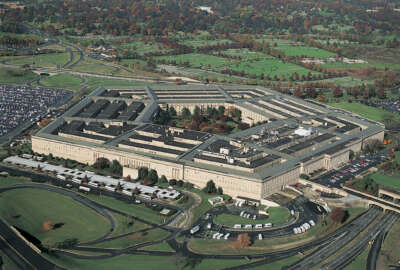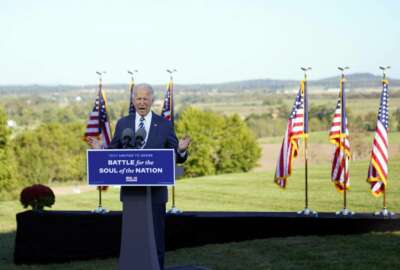
Industry reacts to the latest strategies out from the Defense Department
The National Defense Strategy and the DoD Strategic Management Plan emphasized rivalry with China and the need to protect space and cyber assets.
Best listening experience is on Chrome, Firefox or Safari. Subscribe to Federal Drive’s daily audio interviews on Apple Podcasts or PodcastOne.
China, data, campaigning, modernizing. Those are just some of the key words in two just-out documents. The National Defense Strategy and the DoD Strategic Management Plan not surprisingly, emphasized rivalry with China and the need to protect space and cyber assets. For what industry sees initially in these documents, the Federal Drive with Tom Temin turned to the president and CEO of the Professional Services Council, David Berteau.
Interview transcript:
Tom Temin: And David, these documents are kind of broad, they all say a lot of good boilerplate stuff. But this idea of constantly campaigning, improving data analysis chops, establishing a new office of data to the management plan seems like there’s stuff for contractors to grasp onto?
David Berteau: Yes, Both of these documents came out towards the end of last week. On Thursday, the unclassified version of the National Defense Strategy, it’s 80 pages long. The very next day, the 94-page Strategic Management Plan, which highlights its connection to the day before, this National Defense Strategy. Now, it’s important to emphasize that for the national defense strategy, this is the unclassified version, right? There’s a secret version, which was shared with Congress earlier, not available for for us to discuss, obviously, on your show here. But we go through these with a fine tooth comb to say, Okay, what does this mean for contractors, because documents themselves don’t translate into resources, they don’t translate into budget priorities. They certainly don’t translate into solicitations and awards and new contracts. But they frame the way in which DoD will approach those. And so that’s how we look at it. So what do they hold for government contractors? Well, let’s take a look at them.
Tom Temin: All right. One of the things that Secretary Lloyd Austin emphasizes in the defense strategy itself is campaigning, “the conduct and sequencing of logically linked military activities to achieve strategically aligned objectives over time,” have we seen that word before, in earlier strategies?
David Berteau: We’ve seen the word campaigning, but not used in the way it is here. And I think that’s really an indication of a recognition of how far China has come. If you go back over the national defense strategies, and there’s typically one every four years and it’s connected to a broader White House National Security Strategy. Each administration does its own. Over time, the way we emphasize China and talk about China in these reports, has been changing. And in this case, you know, I don’t know whether it’s the acute threat that’s Russia, or the the long-term consequential dynamic that China presents. I really can’t tell the difference between those two, it may be that they’re both in each category, but to a lesser degree, perhaps. But the real question is, what do they mean by that, in terms of going forward? I think the implication is that we’re going to pay a lot more attention to our ability as a nation and with our allies and partners, both to deploy forces into potential combat areas, and also to sustain and support those forces. That is new, that emphasis is much stronger in this strategy than I’ve seen. Anytime in the past. As you know, at PSC, we spend a lot of time on the sustainment end of things, because that’s where contractors most come into play.
Tom Temin: Sure. And the other thing that caught my eye, again, in the Defense Strategy itself was, he mentioned strengthening and modernizing command and control systems for the nuclear enterprise. I don’t think that is necessarily a reaction to the threats from Russia. But the fact that this simply has been neglected for quite a long time.
David Berteau: It has and it’s recognized. And actually, this administration has taken a unique approach because they’ve incorporated into their national defense strategy, two other documents. One is the Nuclear Posture Review, again, updating the one from the previous administration, and the Missile Defense Review, updating the one from the previous administration. By merging all of these together, it actually does provide an opportunity to highlight some common areas of interest. Command and control being one of them that actually affects all three of these areas; that nuclear command and control, of course, is specific to the Nuclear Posture Review. There are two big issues that flow from this, though. One is, what does it mean for resources, because ultimately, strategies without the resources to implement them are just a nice document to have. You may have it printed it on your shelf, or you may just have it stored in your electronic media, but you need the resources in the budget. And a big question that in my mind, and I think we’ve looked for examples of this is to what extent does the National Security Strategy and National Defense Strategy that is already reflected in the President’s FY ’23 budget, which of course has been on the Hill since since last spring last April, in its details, and to what extent is does it reflect there and to what extent will it be in the FY ’24 budget which is a budget that DoD and the White House is building today? We’ll have to wait and see about ’24 for ’23. It’s hard to map them back because this document wasn’t out when that budget was submitted. But that’s where the contracts will be coming from. The contracts we’re pursuing over the next few months and years.
Tom Temin: We are speaking with David Berteau, president and CEO of the Professional Services Council. And on the strategic management side, I didn’t see a whole lot about procurement or business systems modernization, I mean, it’s in there. But one thing I did see early on was the establishment of a Chief Digital and Artificial Intelligence Office. Now they have artificial intelligence units already in DoD, this looks like a move to maybe elevate that even higher, and maybe acknowledge how important this all really is.
David Berteau: Right, before the plan was even issued, that office had been stood up. And if you go back and look at the memorandum from the deputy secretary announcing it, the idea was to do something that you hinted at, which is to take the myriad offices that are already established across the department and integrate them, combine them in a way that actually increases its focus and integrate the collaboration and cooperation necessary here. It’s a little too soon to tell how well that’s going to work. And you’re right in pointing out that ultimately, its ability to get things done depends on the enablers. The procurement system and processes, right, the integration of data across the board, the way in which the department modernizes its systems, legacy systems, whether it’s IT or weapon systems, or command and control systems, and the way in which they manage the legacy systems that are left behind. The report, the plan, the strategic management plan, hints at these, actually cites these in individual cases, if you use the search mechanism, you’ll find a sentence here or there. But it’s not pulled together in such a way that it allows industry to see how it’s going to turn into real support needed. In order to have that execution be successful, we’re gonna have to see that develop over time.
Tom Temin: And these things are written by committee anyway. So it’s hard for any one dominant theme to actually dominate. The other note that I took from this was they mentioned a new framework for strategic readiness. And I think people understand that readiness is a huge issue for the military right now. Their facilities are old, a lot of the platform’s are old and not really available commonly. And they mentioned specifically the need to have readiness without carving out money that’s needed for long-term building up of forces.
David Berteau: This is the constant tension inside the Defense Department. It was true during the Cold War, it was true during the period after the Cold War. And now I don’t think this is a Cold War we’re entering into, but it’s certainly a period of heightened threat and more significant consequences than we’ve seen over the last 20 or even 30 years. And so I think that attention is necessary, but the tension between the two that is readiness for today, investment in the future, is one that I think DoD hints, in these reports. And I think it’s absolutely true. When you look at the reality of it is we can’t say do one or the other, we have to do both. What does that imply for resources? What does it imply for budgets, particularly in what may be a different congressional environment going forward, we’re going to have to watch very closely. The emphasis on readiness, though, also has to do with sustainment and logistics, because readiness only goes as far as the first day. And then it’s what can you do to support your forces? I think one of the great lessons of the Russian invasion of Ukraine is the challenge of sustaining forward-deployed forces, whether in combat or just ready for combat. You know, the Russians obviously have trouble doing this even close to home. But the lesson for the U.S. is not close to home. It’s across, you know, 8000 miles of an ocean. Allies and partners come into play here. But again, the emphasizing the need for improved logistics and sustainment, which the National Defense Strategy does, which this strategic management plan mentions in places. But it’s short on specifics, we know that contractors provide both the surge potential and the long-term sustainment and readiness support is needed. But only if DoD builds that into its plans, into its budgets and into its contract.
Tom Temin: David Berteau is President and CEO of the Professional Services Council.
Copyright © 2025 Federal News Network. All rights reserved. This website is not intended for users located within the European Economic Area.
Tom Temin is host of the Federal Drive and has been providing insight on federal technology and management issues for more than 30 years.
Follow @tteminWFED






